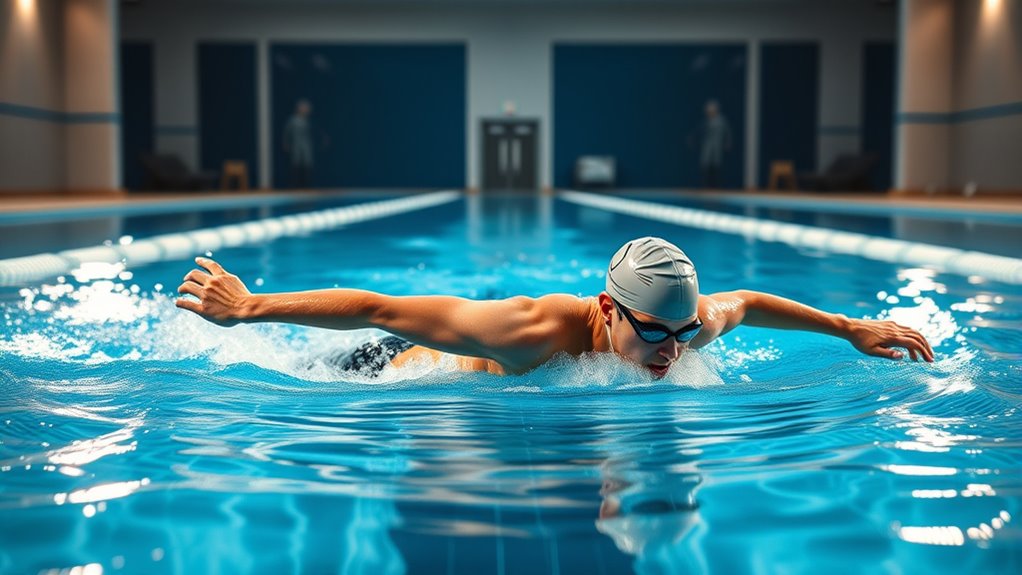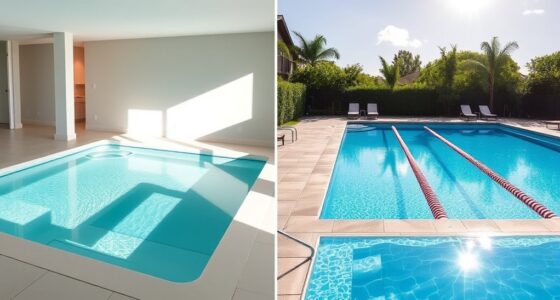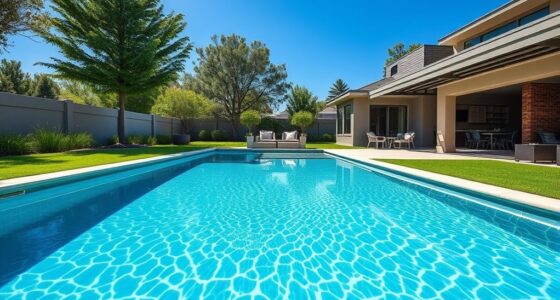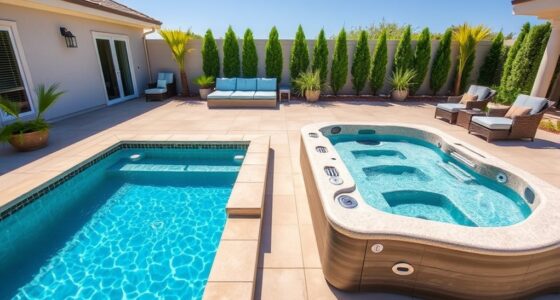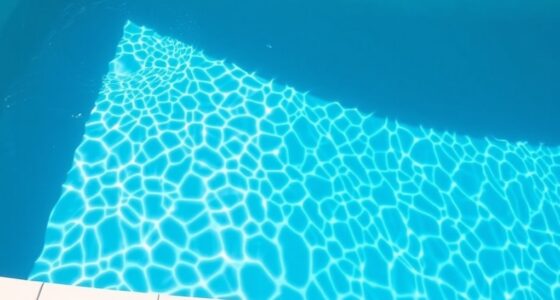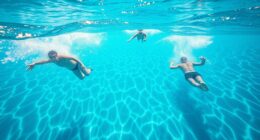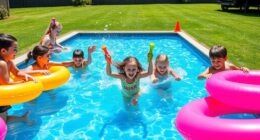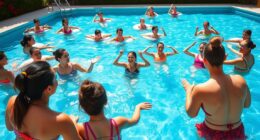To swim faster in an endless pool, focus on refining your technique with key drills. Practice a streamline body position to reduce drag, and work on hip rotation for effortless movement. Incorporate single-arm strokes and catch-pull drills to maximize propulsion. Use kickboard exercises for powerful kicks, and refine underwater dolphin kicks for speed. Maintaining head position and practicing interval training will boost your endurance. Keep exploring these drills to unseal even more speed improvements.
Key Takeaways
- Incorporate streamline body position drills to reduce drag and improve overall swim efficiency in endless pools.
- Practice high elbow catch and fingertip drag exercises to enhance propulsion and arm entry precision.
- Use hip rotation and body alignment drills to create a smooth, effortless stroke flow.
- Focus on underwater dolphin kicks and visual focus to maximize underwater propulsion and streamline.
- Implement speed play and interval sets to build endurance and increase swimming speed effectively.
Streamline Body Position Drill
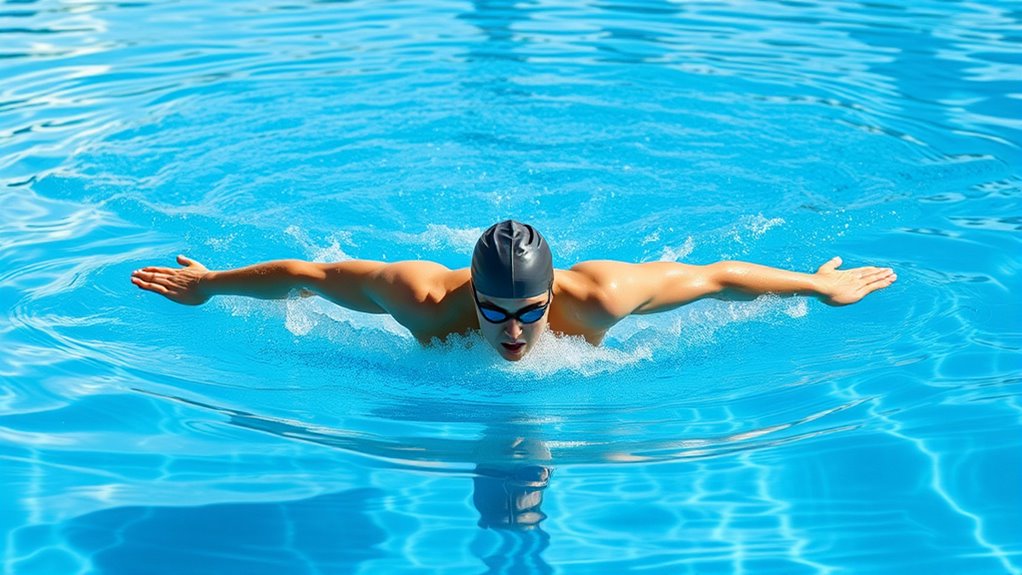
To improve your swimming efficiency, practicing the Streamline Body Position Drill is essential. This drill helps you develop a straight, streamlined posture that reduces drag and conserves energy. Push off the wall with your arms fully extended overhead, fingers together, and your head aligned with your spine. Keep your body tight and straight, engaging your core muscles to maintain a flat position on the water. Focus on keeping your hips high and legs close to the surface. Breathe minimally during the drill, only turning your head to the side if necessary. The goal is to glide smoothly without unnecessary movements. Regular practice sharpens your body awareness and builds muscle memory, making your overall swim technique more efficient and faster.
Single-Arm Technique Focus

Focusing on a single-arm technique allows you to isolate and improve your arm movement, balance, and breathing during each stroke. This drill sharpens your awareness of how each arm contributes to propulsion, helping you identify weaknesses and refine your form. As you swim, you’ll develop better coordination and control, making your entire stroke more efficient.
Here are four ways this drill elevates your swimming:
- Builds muscle memory for consistent, powerful strokes.
- Enhances balance by isolating and stabilizing each side.
- Improves breathing rhythm as you focus on turning your head smoothly.
- Boosts confidence by mastering each arm’s movement individually.
This focused practice brings clarity to your technique, making your swim smoother and faster.
Catch and Pull Efficiency Exercise
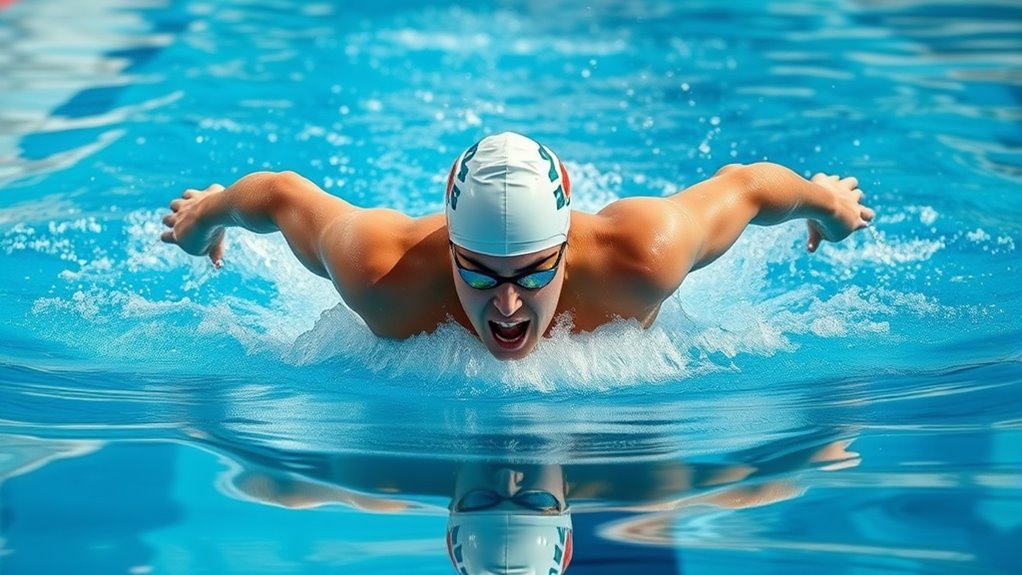
Improving your catch and pull efficiency is essential for maximizing propulsion with less effort. To do this, focus on slow, controlled strokes that emphasize a strong, early catch. Start by swimming with a slight pause at the front of each stroke to ensure your hand is fully engaged before pulling back. Keep your fingertips pointed downward and your elbow high as you initiate the pull, engaging your lats and back muscles. Pull through the water with a smooth, continuous motion, avoiding any jerky or rushed movements. Use a resistance band or tether in your Endless Pool to maintain constant tension, which helps you feel your catch and pull mechanics more clearly. Consistent practice of this drill improves your ability to generate power efficiently during each stroke. Incorporating proper technique can further enhance your swimming performance and reduce fatigue.
Kickboard Balance and Power Drill
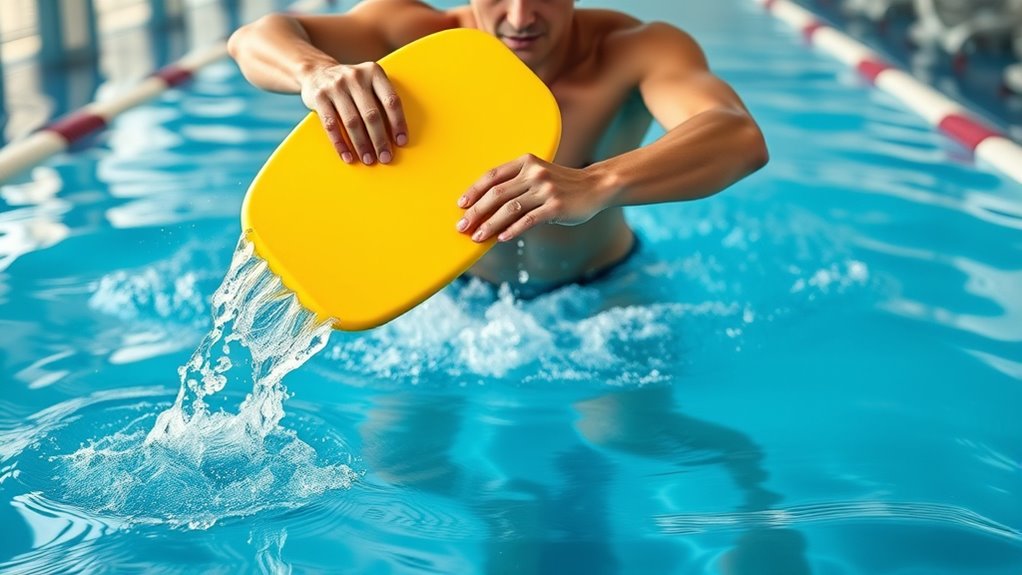
Enhancing your kickboard skills requires maintaining proper balance and generating power from your legs. Focus on keeping your hips high and steady as you kick, which builds core strength and stability. To maximize this drill’s effectiveness, try these key tips:
- Keep your head in line with your spine, avoiding unnecessary movement.
- Engage your core to stabilize your body and prevent wobbling.
- Use long, powerful kicks to propel yourself forward efficiently.
- Maintain a steady rhythm to improve endurance and consistency.
This drill boosts your confidence in maintaining balance while increasing leg strength. Feel the surge of power with each kick, knowing you’re building the foundation for faster, more efficient swimming. Stay focused, push yourself, and watch your skills improve.
Fingertip Drag for High Elbow Entry

Fingertip drag helps you achieve a high elbow entry, improving your streamline and reducing drag. It also boosts your body position in the water, making your stroke more efficient. Plus, this drill strengthens your catch, so you pull more powerfully through each stroke. Incorporating color accuracy into your training can further enhance your visual feedback and overall technique.
Promotes High Elbow Entry
Have you ever wondered how to achieve a smoother, more efficient entry into the water? The fingertip drag drill can help promote a high elbow entry, making your stroke more powerful. When you focus on keeping your elbow high during entry, you reduce drag and improve your pull. This drill trains you to stay mindful of your arm position, ensuring your hand enters cleanly and efficiently. As you practice, you’ll notice: creating designated zones for specific activities or items helps you stay organized and focused on your swimming technique, preventing clutter and distraction.
Enhances Body Position
Maintaining a high elbow entry with the fingertip drag drill not only improves your arm positioning but also positively influences your overall body alignment in the water. When you focus on keeping your elbow high, your body naturally stays more streamlined, reducing drag and increasing efficiency. This drill encourages proper hand entry, which helps you glide smoothly through the water. As your body aligns better, you’ll notice less fatigue and more power with each stroke. Visualize your progress:
| Feel the Fluidity | Notice the Ease | Experience the Speed |
|---|---|---|
| Glide effortlessly | Move with confidence | Swim faster and longer |
Proper body alignment is essential for maximizing your swimming efficiency and reducing unnecessary resistance.
Builds Catch Strength
Incorporating the fingertip drag drill into your swim routine actively builds your catch strength by emphasizing proper arm positioning and control. This drill forces you to focus on high elbow entry and a smooth, efficient pull through the water. As you perform it, you’ll notice your awareness of arm placement increases, leading to more powerful strokes. Additionally, understanding technique drills can help you fine-tune your form and accelerate your progress.
Sculling for Feel and Control

Sculling is essential for developing a better feel for the water and gaining precise control over your strokes. It helps you sense water movement and adjust your hand position for maximum efficiency. To practice, keep your hands relaxed and form small, figure-eight motions with your wrists and forearms. Focus on maintaining a steady pressure through your palms, feeling how the water responds. This drill enhances your ability to gauge water resistance and improves your stroke timing. As you become more comfortable, vary your speed and pressure to refine your control. Consistent sculling builds awareness of water dynamics, leading to more efficient propulsion. Additionally, understanding water resistance can help you optimize your technique for faster swimming. Ultimately, it sharpens your overall feel for the water, making your strokes smoother and more powerful.
Hip Rotation for Better Propulsion
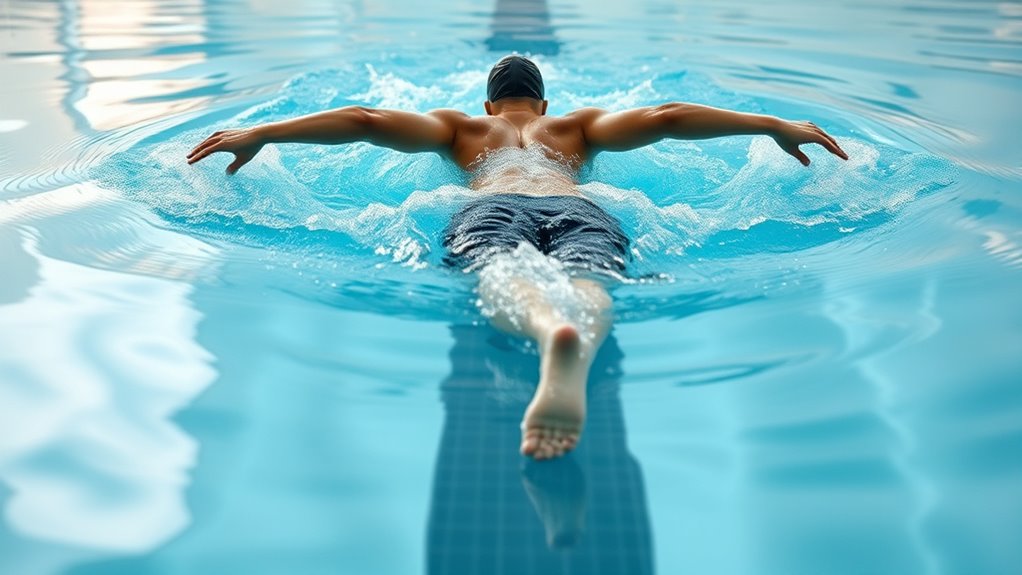
Hip rotation is a key element in generating more powerful and efficient propulsion during your swim strokes. When you rotate your hips correctly, you maximize the reach and streamline your body, reducing drag and increasing speed. Proper hip rotation also engages your core muscles, allowing you to transfer power more effectively from your legs to your arms. To enhance your hip movement, focus on these essential points:
- Feel the rhythm of your body twisting naturally with each stroke.
- Keep your hips aligned to avoid unnecessary resistance.
- Use your core to initiate the rotation rather than just your arms.
- Practice controlled, deliberate twists to build strength and fluidity.
- Understanding headphones can help you listen to coaching cues or music during practice, improving focus and timing.
Mastering hip rotation turns your swim into a more dynamic, effortless motion—propel yourself forward with confidence.
Breathing Rhythm and Timing Drill
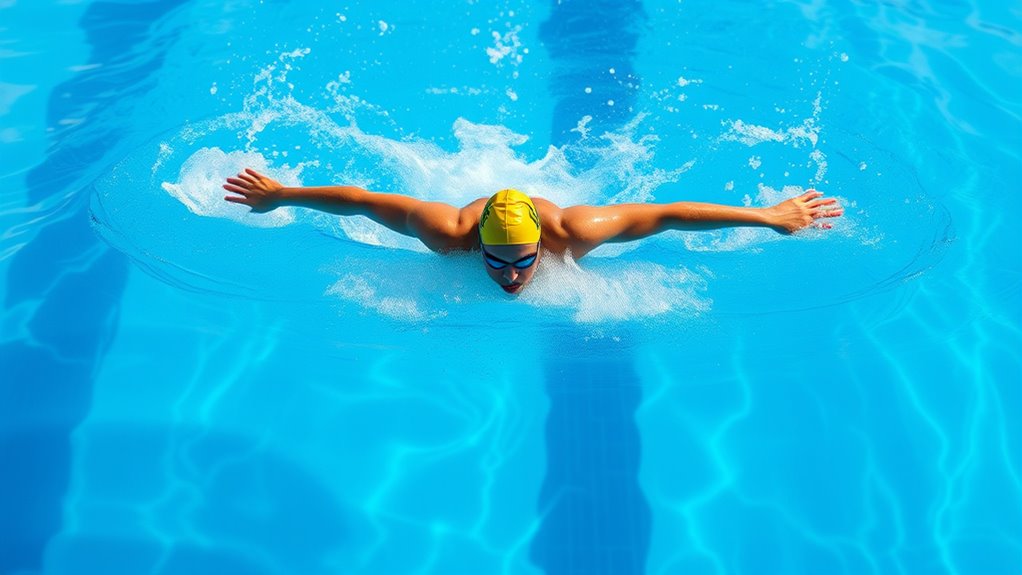
Effective breathing rhythm and timing are crucial for maintaining smooth, efficient strokes and sustaining your endurance throughout your swim. To improve, practice the breathing rhythm and timing drill in your Endless Pool. Begin by swimming a set distance, focusing on inhaling every three strokes and exhaling steadily during each stroke cycle. Keep your breaths relaxed and controlled, avoiding gasping or shallow breathing. As you progress, gradually extend your inhale to four strokes or reduce to two, finding a rhythm that feels natural and sustainable. Timing your breaths with your stroke cycle helps you stay balanced and prevents disruptions in your stroke flow. Consistent practice will develop muscle memory, making breathing seamless and effortless, so you conserve energy and swim faster with better endurance. Incorporating breathing techniques into your routine can further enhance your overall performance.
Glide and Streamline Extension
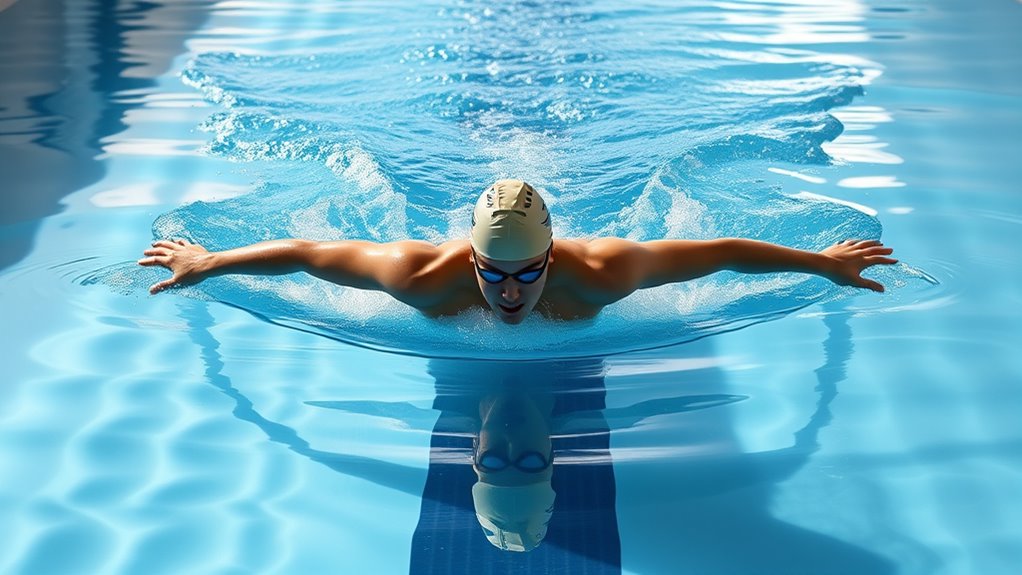
To improve your swim efficiency, focus on perfecting your body position and extending your streamline. A longer, more aligned reach helps you glide smoothly through the water, reducing drag. By refining these aspects, you’ll enhance your glide and overall swim performance. Incorporating active listening and empathy into your technique drills can also foster better awareness of your body movements and water feel.
Perfecting Body Position
Achieving the perfect body position is essential for maximizing your glide and streamline extension in swimming. When you align your body correctly, you reduce drag and move more efficiently through the water. Focus on maintaining a straight line from your head to your toes, keeping your hips high and your core engaged. Feel confident as you become more streamlined and confident with each stroke. To improve this position, remember:
- Keep your head neutral, looking down without lifting or sinking.
- Squeeze your glutes to stabilize your hips.
- Extend your arms fully, reaching forward with fingertips aligned.
- Engage your core to hold a tight, elongated body.
- Recognize that body position plays a profound role in reducing drag and enhancing swimming efficiency.
Mastering these elements will make your body feel effortless and powerful in every swim.
Extending Streamlined Reach
When you focus on extending your streamline reach, you maximize your glide and minimize resistance in the water. To do this, reach forward as far as possible during every stroke, keeping your arms extended and your body aligned. Focus on reaching with your fingertips first, then follow through smoothly, maintaining a tight core. Avoid rushing the extension; instead, aim for a controlled, fluid movement that lengthens your body. This not only improves your propulsion but also helps you conserve energy by reducing drag. Practice holding your extended position briefly before initiating the next stroke to reinforce the habit. Consistently extending your streamline reach makes your swimming more efficient, allowing you to go farther with less effort and ultimately swim faster.
Enhancing Glide Efficiency
Enhancing glide efficiency starts with mastering your streamline extension and maintaining it throughout each stroke. When you focus on long, steady glides, you minimize drag and conserve energy. To boost your glide, consider these key actions:
- Visualize a stretched wire connecting your fingertips to your toes, keeping your body long and aligned.
- Engage your core to hold your streamline position, preventing unnecessary sagging.
- Initiate each stroke with a powerful, streamlined push-off, maximizing momentum.
- Focus on smooth, controlled breathing that doesn’t disrupt your streamlined posture.
Speed Play With Interval Sets
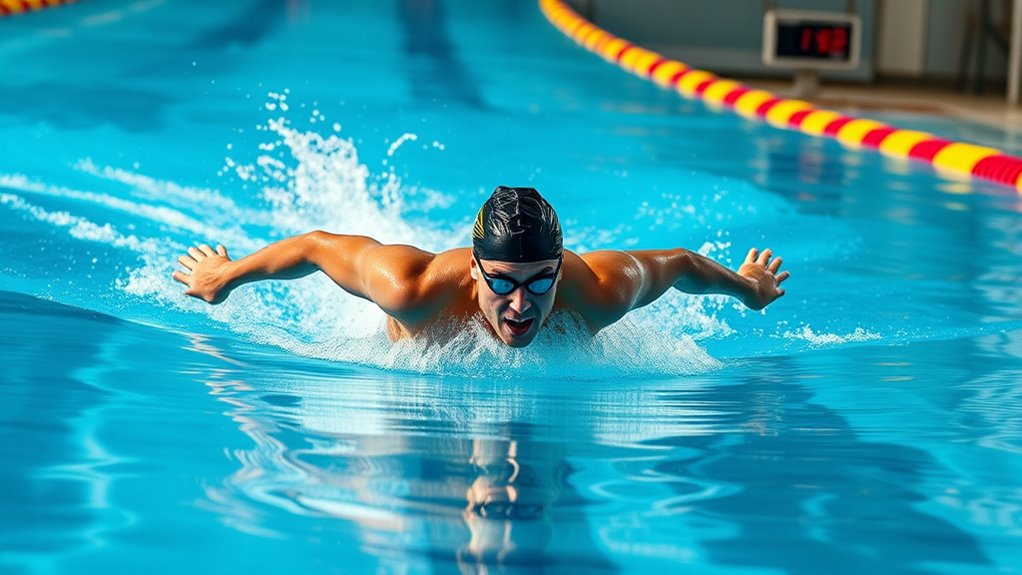
Incorporating speed play with interval sets into your swim training can substantially boost your overall pace and endurance. By alternating between fast, intense efforts and recovery periods, you push your body to adapt to varying speeds, improving both speed and stamina. For example, swim 50 meters at your maximum sustainable pace, then recover with 25 meters of easy swimming. Repeat these cycles multiple times, gradually increasing the intensity or duration as you progress. This approach keeps your workouts dynamic and prevents plateaus. Speed play with interval sets helps develop your anaerobic capacity and mental toughness, making it easier to maintain higher speeds during competitions. Consistently integrating these drills into your routine will enhance your overall performance in the water.
Underwater Dolphin Kick Practice
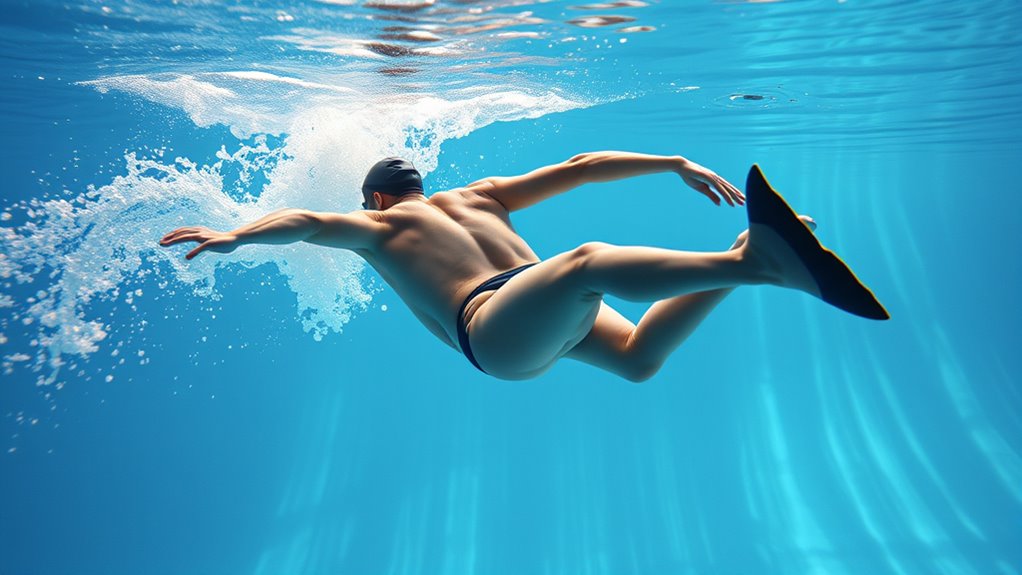
Building on your interval training, focusing on underwater dolphin kicks can substantially improve your overall swim speed and efficiency. This drill helps you develop explosive power and streamline your body for less drag. To make the most of it:
- Start with strong push-offs to maximize underwater distance.
- Maintain a tight core to keep your body streamlined.
- Focus on rhythmic, powerful kicks rather than just fast movements.
- Extend your underwater phase to increase propulsion without fatigue.
Practicing these elements not only boosts your speed but also builds confidence in your underwater skills. Consistent underwater dolphin kick drills translate to smoother, faster turns and improved overall performance in the water. Push yourself to perfect this technique, and you’ll notice significant gains in your swimming efficiency.
Visual Focus and Head Position Drills
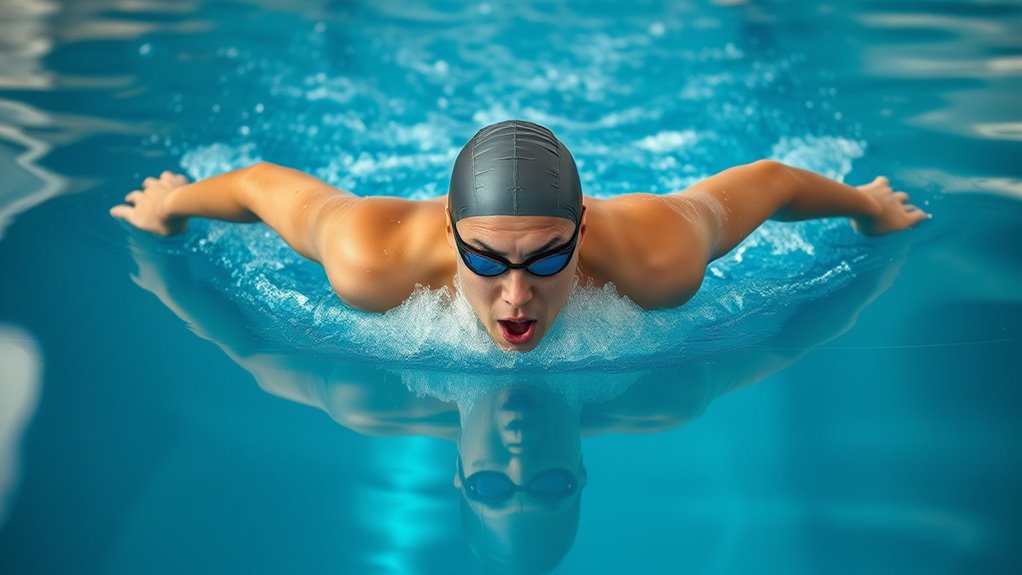
Maintaining proper visual focus and head position is essential for maximizing your swim efficiency and reducing drag. When you keep your eyes looking straight ahead or slightly downward, you streamline your body and prevent unnecessary resistance. Incorporate drills that emphasize steady head alignment, such as focusing on a fixed point on the wall or pool floor. Practice slow, controlled strokes while consciously maintaining your head’s position, avoiding excessive lifting or rotation. Using a mirror or recording your swim can help you identify and correct any misalignments. Consistent focus on your visual target and head position trains your muscles to hold proper form naturally, leading to smoother, faster strokes. Over time, these small adjustments markedly improve your overall swim speed and endurance.
Frequently Asked Questions
How Can I Prevent Injuries While Practicing These Drills?
To prevent injuries while practicing these drills, always warm up properly before starting and cool down afterward. Pay attention to your body signals and avoid pushing through pain. Use correct form and technique, and don’t rush through exercises. Incorporate rest days to allow recovery, stay hydrated, and stretch regularly to improve flexibility. If you feel persistent discomfort, consult a coach or healthcare professional to adjust your routine accordingly.
What Equipment Is Essential for Optimal Drill Performance?
You’ll want a few key pieces of equipment to optimize your drills, like swim fins for added propulsion and resistance, and a pull buoy to focus on your upper body. A kickboard helps improve your leg kick, while a snorkel allows for better breathing technique. These tools might seem simple, but they’re powerful allies—making your practice more effective and enjoyable, unlike just relying on your body alone.
How Often Should I Incorporate These Drills Into My Training?
You should incorporate these technique drills into your training at least 2-3 times a week. Consistency is key to seeing improvements, so aim for short, focused sessions that target specific skills. Balance drill work with overall workout routines, and gradually increase intensity as you get more comfortable. Listening to your body helps prevent injury, so adjust frequency if you notice signs of fatigue or strain.
Can These Drills Help With Open Water Swimming?
Absolutely, these drills can improve your open water swimming by building your technique, increasing your efficiency, and boosting your confidence. When you focus on perfecting your form in the Endless Pool, you transfer those skills to open water, helping you swim straighter, conserve energy, and handle challenging conditions. Practice regularly, stay mindful of your technique, and you’ll find yourself more comfortable and faster during your open water swims.
Are There Modifications for Beginner Swimmers?
Yes, there are modifications for beginner swimmers. You can start with simplified drills that focus on basic techniques like body positioning and breathing. Reduce the intensity and duration of each session, and use floatation aids to build confidence. Break down complex movements into smaller steps, and gradually increase difficulty as your skills improve. These adjustments make the drills more accessible, helping you progress safely and effectively.
Conclusion
By mastering these 12 drills, you’ll open a smooth, lightning-fast stroke that feels like slicing through glass. Think of your technique as a finely tuned engine, each movement fueling your speed and efficiency. With dedication, your swimming becomes a dance of power and grace—turning the endless pool into your personal river of progress. Jump in, practice these drills, and watch your pace soar like a bird breaking free from the water.
